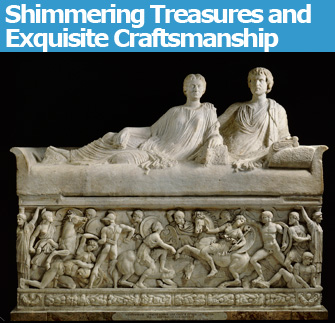 |
|
Marble sarcophagus from Thessalonika (c. 180). © RMN/René-Gabriel Ojéda |
For its exhibition “In the Kingdom of Alexander the Great: Ancient Macedonia,” a wide-ranging of the extraordinary ancient Macedonian civilization, which …
 |
|
Marble sarcophagus from Thessalonika (c. 180). © RMN/René-Gabriel Ojéda |
For its exhibition “In the Kingdom of Alexander the Great: Ancient Macedonia,” a wide-ranging study of the extraordinary ancient Macedonian civilization, which lasted from 1500 B.C.E. to the Roman Imperial era, the Louvre has unearthed a collection of magnificent treasures. Focusing on various excavations, from the 19th century to the present, the show includes marble sarcophagi, temple columns, portraits, statues, jewelry, weapons, helmets, drinking cups and culinary vessels, almost all of which look as if they were made yesterday.
Some of the tiniest pieces are so exquisitely crafted that it is regrettable that the crowds that will inevitably fill the Louvre exhibition halls will make it difficult to study them at close quarters.
Among the chief attractions, the shimmering crowns of gold leaves inevitably catch the eye, but there are many other memorable pieces. I particularly liked the weirdly wonderful white marble votive relief (from Thessalonika, 100 B.C.E.), consisting solely of three ears, signifying the gods listening to the mortals, and a gorgeous female figure dating from 300 B.C.E., her eyes cast downward, who looks as if she could be a Renaissance Madonna.
Anybody misled by the title of the show to expect a focus on Alexander the Great will be disappointed to see only a few statues and artifacts relating to him, mostly placed as a postscript at the end of the exhibition.
Of the many Macedonian rulers, King Archelaus, who reigned from 413-399 B.C.E., stands out for his exceptional encouragement of the arts. Not only did the greatest painter of the age, Zeuxis, work under his patronage, but the dramatist Euripides wrote his tragedies, Archelaus and The Bacchae, in Macedon during Archelaus’s reign.
Some of the exhibition’s wall text is translated into English and Greek, but the individual display notes are only in French and far too small to read with ease. But if you simply want to luxuriate in the wealth of Macedonian treasures on display, the show will not disappoint. Just try and visit it either first thing in the morning or soon before closing time; otherwise the sheer volume of human traffic might spoil your visual pleasure.
Musée du Louvre: Hall Napoléon. Métro: Palais-Royal-Musée du Louvre. Open Wednesday-Monday, 9am-6pm (until 10pm on Wednesday and Friday). Closed Tuesday. Admission: ![]() €11.00. Through January 16, 2012. www.louvre.fr
€11.00. Through January 16, 2012. www.louvre.fr
Reader Owen McGowan writes: “Here we go again, yet another pack-em-in art show that hinges falsely on a Big Name. Furthermore, it is so time to stop all mention of Alexander the Great. Alex the Idiot traipsed all over the barren mountains of Afghanistan and vile deserts that were, natch, ‘deserta’ to die young and alcoholic. For what gain? If he had headed next door to ‘Italy,’ all fertile Europe would have been his. Further furthermore, it’s time to call him Wrong-way Alex.”
Please support Paris Update by ordering books from Paris Update’s Amazon store at no extra cost. Click on your preferred Amazon location: U.K., France, U.S.
Reader Reaction: Click here to respond to this article (your response may be published on this page and is subject to editing).
More reviews of Paris art shows.
© 2011 Paris Update
Favorite